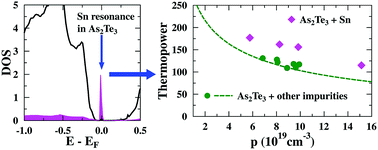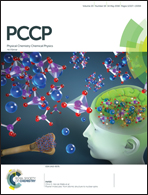An Sn-induced resonant level in β-As2Te3
Abstract
Distortion of the density of states by an impurity-induced resonant level has been shown to provide an effective strategy to improve the thermoelectric performance of semiconductors such as Bi2Te3, PbTe or SnTe. Here, combining first-principles calculations and transport property measurements, we demonstrate that Sn is a resonant impurity that distorts the valence band edge in p-type β-As2Te3. This remarkable effect is characterized as a prominent, sharp peak in the electronic density of states near the Fermi level. To illustrate the particular influence of Sn on the thermopower of β-As2Te3, the theoretical Ioffe–Pisarenko curve, computed within the Boltzmann transport theory, is compared with the experimental results obtained on three series of polycrystalline samples with substitution of Ga and Bi for As and I for Te. While Ga and I behave as conventional, rigid-band-like dopants and follow theoretical predictions, Sn results in significant deviations from the theoretical curve with a clear enhancement of the thermopower. Both electronic band structure calculations and transport property measurements provide conclusive evidence that this enhancement and hence, the good thermoelectric performances achieved at mid temperatures in β-As2−xSnxTe3 can be attributed to a resonant level induced by Sn atoms. The possibility to induce resonant states in the electronic band structure of β-As2Te3 opens new avenues to further optimize its thermoelectric performance.



 Please wait while we load your content...
Please wait while we load your content...